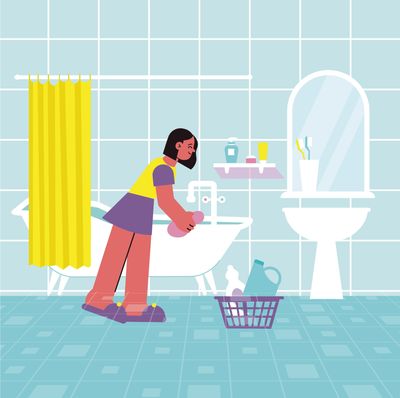How to clean your bathroom in 10 minutes, 30 minutes or an hour

When it comes to cleaning, there’s one room that inspires the most dread. “We’re like, ‘Oh, God, we have to clean the bathroom,’ ” says Stephanie Cummings, chief executive of Please Assist Me, a Washington, D.C.-area firm that offers home management services to renters.
The worst thing you can do is shut the bathroom door and leave the work for another day. “Don’t close your eyes and pretend it doesn’t exist,” Cummings says. The more consistent your bathroom cleaning, the less daunting the task.
Ideally, folks should sanitize their bathrooms every day, at least with a daily shower cleaner. For those of us with less-than-ideal cleaning regimens, here are tips and tricks that experts recommend deploying based on how much time you have.
If you have 10 minutes: Touch it up
Your first step before every clean: “Put everything in its place,” advises Angela Richardson, founder of the nontoxic cleaning product line Pur Home. This includes hair products, makeup, perfume and anything else cluttering your counter.
Next, choose your tool. For a 10-minute clean, Cummings recommends using disposable wipes that already have a cleaning solution on them.
Do a quick swipe of your counters with the wipes, Cummings says. In the shower, spot clean “to get rid of those areas that are going to be problem areas in the future.”
Save the big toilet cleaning for when you have more time. “Sometimes, just lifting up the lid and using a quick wipe can keep things clean,” Cummings says, adding that your toilet-cleaning schedule also depends on the people you live with and how tidy they are when using the bathroom.
If you have 30 minutes: Use more tools
An extra 20 minutes means you can work with more supplies. Richardson recommends having at least three cloths: one for the shower, one for the sink and another for the toilet, although the last could instead be a brush.
“There are different bacteria and fluids in each of those different places, so you don’t want to cross-contaminate as you’re cleaning,” she says. “That defeats the purpose.”
Cummings swears by microfiber towels. “A lot of the time, people use brushes or sponges longer than they should,” she says. “Because of that, they’re cleaning with brushes or sponges that might have mildew on them, and you actually might be spreading mold.”
Microfiber towels pick up dirt easily and can be thrown in the washing machine after. An all-purpose spray suffices for a 30-minute session. If you have a glass-specific cleaner, add it to the mix.
Cummings recommends spraying down your stainless-steel appliances first. “Stainless steel has a tendency to streak even more than windows, so use that fresh microfiber cloth to take care of your stainless steel, then you can work on your mirrors, counters, sink and shower,” she says.
For your shower, she suggests using an uncommon detergent. “Put your kitchen dish soap on a microfiber towel, wipe it down, and let it dry. Your tiles will sparkle.” In 30 minutes, you’ll also have time to clean your floors.
After sweeping, Cummings recommends using Swiffer-like cleaners or steam mops that can “disinfect floors as they clean because they’re so hot.” They also effectively clean crevices, she says.
Don’t forget to take out your trash. “Put the trash by the door so that, on your way out from mopping, you can grab it, and everything is clean,” Richardson says.
If you have one hour: Go for a deep treatment
For an hourlong cleaning, most of your time might be spent on the shower because “that’s where we spend most of our time in the bathroom,” Cummings says. This time around, your cleaning areas should be more targeted. “I’m thinking about tile grout,” she says.
This is also when stronger chemicals make an appearance, although Richardson urges caution when using bleach-based products, which can create problematic fumes. Overusing cleaning products is another problem. “People are like, ‘I just want to make sure that it’s clean.’ Just do it by the instructions, and I can guarantee you that it’ll be clean,” she says.
After using the correct amount of bleach-based product on surfaces, you should leave the room for 20 or 30 minutes, Cummings says. “A lot of times, when people have mildew or mold, they spray it and then immediately start scrubbing. But that doesn’t give the product enough time to actually work,” she says.
“So spray everything down really intensively, let it sit, and when you come back, you’ll notice that half the work’s already done for you.” When you return, consider scrubbing your shower with a toothbrush. “It’s really your best friend to get those problem areas,” Cummings says.
While your cleaning products are marinating, turn to the laundry. “People often forget that you can throw your floor towels and bath mats into the washing machine,” Cummings says. “Most of them will do OK in the washing machine unless you have something really delicate. But wash them on the low cycle and let them air dry.”
This is also a good time to organize, Richardson says. “Make sure that the linen closet is neat. Organize perfumes, lotions and anything that’s underneath the sink.” After organizing and wiping down all your surfaces, sweep and mop the floors, and empty the trash, and you’re good to go.